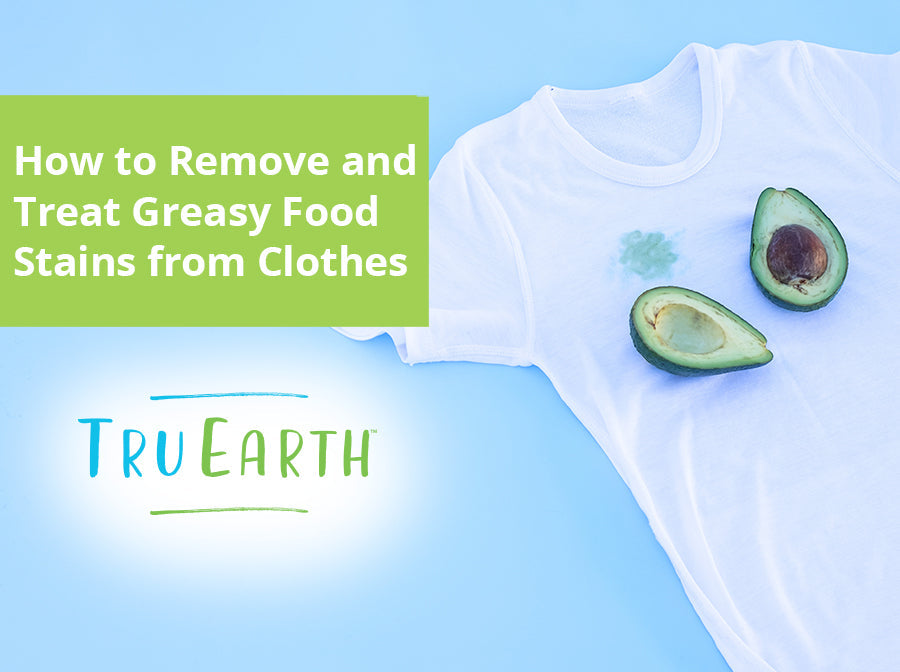Als het om vlekken gaat, is eten de grootste boosdoener. Eten is een activiteit die vaak gepaard gaat met afleiding: kletsen met familieleden, autorijden, tv kijken. Een verdwaalde chip kan zomaar op je schoot belanden, een vol glas omvallen of een hapje van een vork laten vallen. Tenzij je bladgroenten of magere zuivel eet, bevatten vrijwel alle bereide voedingsmiddelen een soort olie. Dat betekent dat een groot deel van de voedselvlekken die op onze kleding terechtkomen, vetvlekken zullen zijn. Voedselvlekken op oliebasis kunnen lastig (maar niet onmogelijk) te behandelen zijn, maar als je snel handelt en dept terwijl ze nog fris zijn, zouden de meeste kledingstukken een vetvlek moeten overleven.
Welke soorten voedingsmiddelen veroorzaken vetvlekken?
Als we het over vettige voedselvlekken hebben, hebben we het meestal over de olieachtige resten die kookoliën (zoals olijfolie, groente- en notenolie) achterlaten. Deze ingrediënten vind je terug in dingen zoals sauzen, marinades, saladedressings, vinaigrettes, dipsauzen, vlees en groenten die in olie zijn geroosterd of gebakken, gefrituurde hoofdgerechten en snacks zoals chips, crackers en gebak.
Wat u nodig hebt om vlekken veroorzaakt door vet eten te behandelen
- Een bot schrapertje (een bot mes, spatel, creditcard, etc.)
- Stromend water / een gootsteen
- Papieren handdoek of een schone, absorberende doek
- Een absorberend poeder zoals zuiveringszout of maizena
- Tru Earth wasmiddel eco-strips
Hoe verwijder je vlekken veroorzaakt door vet eten in 7 eenvoudige stappen
Stap 1: Identificeer het type stof
Controleer hetwaslabel om te zien hoe kwetsbaar de stof is en hoe deze gewassen moet worden.
Let op : De volgende vlekkengids is bedoeld voor kledingstukken die in de wasmachine of met de hand gewassen kunnen worden. Voor vintage kleding of kleding die alleen chemisch gereinigd mag worden, doorloopt u stap twee en drie en brengt u deze vervolgens direct naar een professionele stomerij.
Stap 2: Verwijder alle overtollige voedselresten
Verwijder eventuele overtollige voedselresten van de stof met een bot voorwerp (zoals een botermesje of een creditcard). Zorg er daarbij voor dat u de etensresten niet verspreidt of overbrengt op andere delen van het kledingstuk, want dan kunnen er nog meer vlekken ontstaan.
Stap 3: Bestrooi de vettige vlek met een absorberend poeder
Schud een royale hoeveelheid baking soda, maïzena of talkpoeder over de vlek. Laat het 10 minuten intrekken. Het poeder absorbeert achtergebleven vet en zorgt ervoor dat de korrels in kleine klontjes samenklonteren. Gooi de klontjes weg en schud het kledingstuk uit. Als er nog steeds vetresten achterblijven, herhaal deze stap dan nogmaals.
Indien gewenst, kunt u de vlek deppen met een absorberende papieren handdoek of een schone doek.
Stap 4: Breng een geconcentreerde vlekkenbehandeling aan met Tru Earth voordat u de vlek wast .
Scheur een strook Tru Earth in kleine stukjes en doe deze in een ondiepe kom. Voeg een eetlepel (15 ml) heet kraanwater toe om het op te lossen. Roer met een lepel tot een pasta, voeg indien nodig kleine hoeveelheden water toe. Smeer het concentraat op de vlek en druk het mengsel er zachtjes in, zodat de oppervlakteactieve stof zijn werk kan doen en de resten van de stof loslaat.
Laat het concentraat 10-15 minuten intrekken. Gebruik indien nodig een zachte borstel om de vlek te borstelen, van de buitenrand naar het midden toe. Spoel af.
Stap 5: Tijd om te wassen
Als het kledingstuk machinewasbaar is, stop het dan in de wasmachine samen met een Tru Earth wasmiddel eco-strip op het normale wasprogramma.
Voor artikelen die alleen met de hand gewassen mogen worden, scheurt u de strip af, legt u de stukken in een gootsteen of teil en overgiet u ze met koud of warm water, maar niet heet. Laat het weken, schud het artikel vervolgens goed door en spoel het af.
Stap 6: Hangend drogen
Doe het kledingstuk pas in de droger als u klaar bent met het behandelen van de vlek. De hitte van de machine zorgt ervoor dat de resterende vlekken zich vastzetten, waardoor ze permanent worden.
Stap 7: Inspecteer de vlek
Is het probleem opgelost? Zo niet, herhaal dan de vlekkenbehandeling in stap vier en was het kledingstuk opnieuw.
Gratis verzending*


